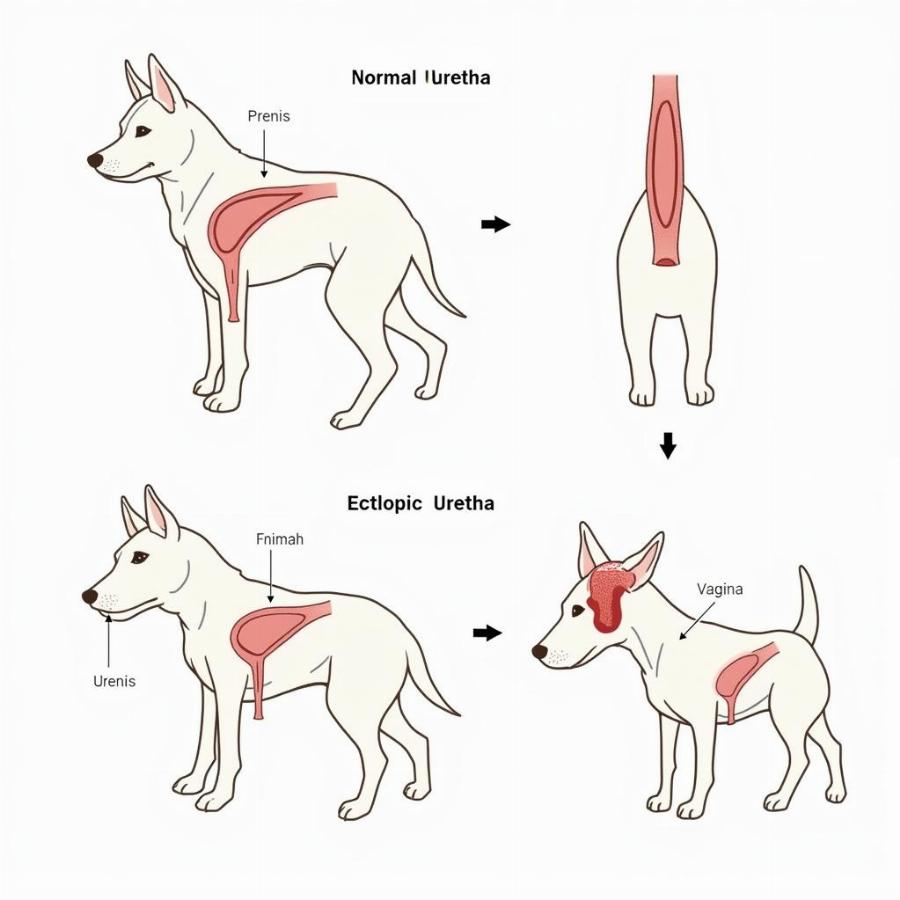Ectopic urethra in dogs is a congenital abnormality where the urethra, the tube that carries urine from the bladder out of the body, opens in an abnormal location. This condition can affect both male and female dogs, though it’s more commonly seen in males. Understanding this condition, its potential complications, and treatment options is crucial for providing the best care for your furry friend.
What is an Ectopic Urethra?
An ectopic urethra develops during fetal development when the urethral groove fails to close properly. In males, the urethra can open on the underside of the penis (hypospadias), within the perineum (perineal urethra), or even within the rectum. In females, it can open into the vagina or vestibule. This misplacement can lead to urinary incontinence, infections, and other health concerns.
What are the common symptoms of ectopic urethra in dogs? Typically, persistent urinary dripping or incontinence, especially after spaying or neutering, can signal an ectopic urethra. Skin irritation around the abnormal opening is also common.
 Diagram of Ectopic Urethra in a Dog
Diagram of Ectopic Urethra in a Dog
Diagnosing Ectopic Urethra in Dogs
Diagnosing an ectopic urethra often involves a thorough physical examination by a veterinarian. They will carefully examine the genital area to locate the urethral opening. Further diagnostic tests such as contrast urethrography or cystoscopy may be needed to confirm the diagnosis and assess the extent of the abnormality. Early diagnosis is key to minimizing potential long-term complications.
How can an ectopic urethra be confirmed? While a physical exam can often identify the issue, imaging techniques like contrast urethrography provide a detailed view of the urethra, confirming the ectopic opening and identifying any associated abnormalities.
Treatment Options for Ectopic Urethra
Treatment for an ectopic urethra typically involves surgical correction. The specific surgical technique will depend on the location of the ectopic opening and the severity of the condition. The goal of surgery is to redirect the urethra to its normal anatomical position, restoring normal urinary function and preventing further complications. Post-operative care is crucial for successful recovery.
Is surgery always necessary for ectopic urethra? While many cases require surgical intervention to correct the abnormality and prevent complications, mild cases, especially in females, may be managed with medical management, focusing on controlling urinary tract infections and managing incontinence.
Living with a Dog with Ectopic Urethra
Even after successful surgical correction, some dogs may experience occasional urinary incontinence. It’s important to maintain good hygiene in the genital area to prevent skin infections. Regular veterinary check-ups are also recommended to monitor for any recurrence or complications. With proper care and management, dogs with corrected ectopic urethras can lead healthy and fulfilling lives.
What are the long-term implications of untreated ectopic urethra? Untreated ectopic urethra can lead to chronic urinary tract infections, skin irritation, and even urinary obstruction, which can be life-threatening. Early intervention and treatment are essential for a positive outcome.
Conclusion
Ectopic urethra in dogs is a manageable condition, especially with early diagnosis and appropriate treatment. Understanding the signs, diagnosis, and treatment options can empower you to make informed decisions about your dog’s health. Don’t hesitate to consult with your veterinarian if you suspect your dog may have an ectopic urethra.
FAQs
- Is ectopic urethra hereditary in dogs? While some breeds may have a higher predisposition, it’s not always directly hereditary.
- Can female dogs with ectopic urethra have puppies? Yes, but there’s a potential risk of passing the condition on to offspring.
- How successful is surgical correction for ectopic urethra? Surgical success rates are generally high, especially with early intervention.
- What are the signs of a urinary tract infection in dogs? Frequent urination, straining to urinate, bloody urine, and lethargy are common signs.
- What’s the typical recovery time after surgery for ectopic urethra? Recovery usually takes a few weeks, with gradual return to normal activity.
- Are there any alternative treatments to surgery for ectopic urethra? In some cases, medical management may be an option, but it depends on the severity.
- How can I prevent my dog from developing an ectopic urethra? As it’s a congenital condition, prevention is not typically possible.
Related Topics
Beaut Dogs is your trusted source for all things dog-related, providing reliable and in-depth information on the world of canine companions. We offer a wealth of knowledge on breed characteristics, care tips, and expert advice to help you provide the best care for your beloved pet. When you need support, please contact us via Email: [email protected] to receive detailed and accurate answers from Beaut Dogs. Visit https://beautdogs.com today to explore the wonderful world of dogs and discover how to care for them best!